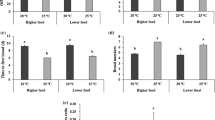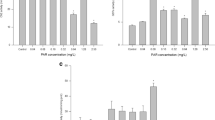Abstract
Stressors can induce specific responses in enzyme function and energetic equilibrium. The hypothesis is tested that there are metabolic responses to stress, measured by a change in specific activity of piruvate kinase (PK) and malate dehydrogenase (MDH). Individual D. magna clones were exposed to 3,4-dichloroaniline for 7, 14, or 21 days. Other performed experiments persued the probable adaptation of the organisms borne under stress vs unstressed conditions. PK and MDH activity levels were inhibited after 7 days of 3,4-DCA exposure, whereas 14 and 21 day exposures induced enzyme activities. Enzymatic activities of individuals born under 3,4-DCA stress and reared in a DCA-free medium were compared with enzyme activities from individuals born and reared under control-M4 conditions. The inhibition of MDH at 7 and 21 days in these animals is similar to the responses of stressed animals in the initial phase of increased production. There was no significant effect on fecundity in DCA-tolerant animals. However, when the first generation of parents (under stress) were compared to DCA-tolerant animals (offsprings grown under normal culture conditions), a significant increase in fecundity was observed. This agrees with the decreased respiration under non-toxic conditions, hence, lower metabolic costs result during unstressed conditions, which may be an adaptative response to an environment free of stress.
Similar content being viewed by others
References
Barber I, Baird DJ, Calow P (1990) Clonal variation in general responses of Daphnia magna Straus to toxic stress: II. Physiological effects. Functional Ecol 4:409–414
Blackstock J (1980) Estimation of activities of some enzymes associated with energy yielding metabolism in the polychaete Glycera alba (Muller) and application of the methods to the study of the effect of organic pollution. J Exp Mar Biol Ecol 46:197–217
Boudou A, Ribeyre F (1989) Fundamental concepts in aquatic ecotoxicology cap. 3. In: Boudou A, Ribeyre F (eds) Aquatic Ecotoxicology: Fundamental Concepts and Methodologies, vol. I. CRC Press, Boca Raton, FL
Elendt BP, Bias WR (1990) Trace nutrient deficiency in Daphnia magna cultured in standard medium for toxicity testing. Effects of the optimization of culture conditions on life history parameters of D. magna. Water Res 24(9):1157–1167
Peterson G (1977) A simplification of the protein assay method of Lowry et al. which is more generally applicable. Anal Biochem 83:346–356
Soares AMVM, Baird DJ, Calow P (1992) Interconal variation in the performance of Daphnia magna Straus in chronic bioassays. Environ Toxicol Chem 11:1477–1483
Author information
Authors and Affiliations
Rights and permissions
About this article
Cite this article
Morgado, J.M., Soares, A.M.V.M. Activity of pyruvate kinase and malate dehydrogenase in Daphnia magna under 3,4-dichloroaniline stress. Arch. Environ. Contam. Toxicol. 29, 94–96 (1995). https://doi.org/10.1007/BF00213092
Received:
Revised:
Issue Date:
DOI: https://doi.org/10.1007/BF00213092




